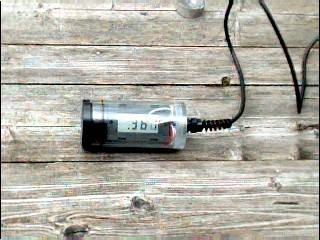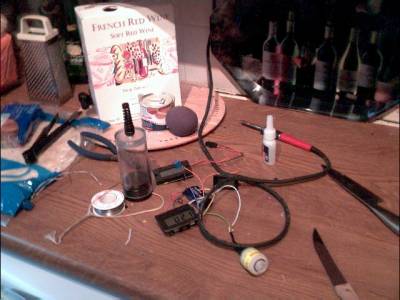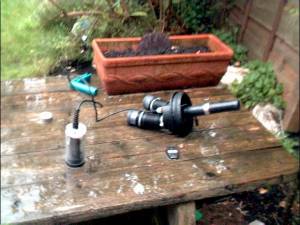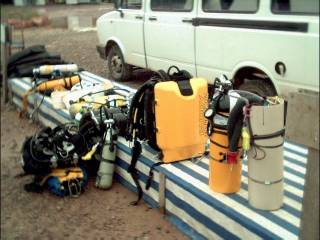| At long last the new display housings have arrived. They comprise of a 1.75" ID lexan tube with an end cap glued into one end. This cap is threaded to take a Sealcon watertight cable gland. At the other end is a delrin plug with two barrel o-ring seals and a simple friction seal holding the plug in place. As the housing runs at atmospheric pressure there is no chance of it coming out underwater. Well, unless I solve problem two, acquiring some waterblocked 2 core cable at a reasonable price which should stop any gas creeping along the cable into the housing. The housings were made by Jake Docktor and a big thank-you goes to him. |  |
 |
The electronics
are simple, a 200mV panel meter which reads the voltage produced by the
sensor. This is in the region of 10mV in air (60mV for O2) for the R17Ds
I am using which isn't very meaningful. By removing one of the resistors
on the board and replacing it with a multi-turn Bourns potentiometer the
display can be adjusted to convert this to ppO2.
Here you can see the high tech clean room where the prototypes are developed. Two broken panel meters (a DPM128 & an Anders OEM33) with one successful meter (a PM438), reading 0.21 if you zoom in. 1 in 3, not bad success rate. The DPM128 are as used in the Oxycheq El Cheapo II analyser, they are cheap & easy to work on but just about impossible to get in the UK. They are also huge. The OEM33s are tiny, cheap & easy to get hold of but I cannot figure out how to calibrate them as they are designed to be housed in DIL sockets on PCBs so have no external bits to hack. The PM438s are a compromise, they are a bit old and have huge resistors & capacitors sticking out of the back so are easily damaged, and I'm having trouble getting them in the housings with the battery too. The OEM33s are ideal as I could easily fit all the displays into one handset. |
| Here is the head of the old rebreather with one of the new handsets fitted. |  |
 |
"Is Your
Rebreather CE approved...?"
Er, well, no... I guess you can understand the concern of your average dive centre owner when confronted with the scene opposite. I suppose the sight of five bodged rebreathers turning up in your nice quarry cannot be the most relaxing way to spend a Saturday afternoon... |
| The
rebreather was test-dived at the Ntional Diving Centre at Chepstow. I had
removed the electronics so that I good check the integrity of the new housings.
After a 30min dive the housing was competely dry inside.
During the dive I had noticed that the loop volume had gone down considerably and when I injected oxygen there was a gurgling noise which made me think the exhale counterlung had flooded. The design of the rebreather had tried to make it survive a flood by trapping water in the bottom of the exhale lung before it got to the scrubber and this is exactly what happened. I stayed underwater another 15min after I suspected the flood just to see how stable the loop was and I was impressed. This is probably the last real diving I will do with the BQX-01 as the new centre section being made by Swiss Technical Diving Equipment, it will hold around 3.5kg of lime and will have 3 sensors in the head. I'm adding a Jetsam KISS valve but still have not decided on what to do for the diluent, whether to stick with manual addition or to go to an ADV. The BQX-01 will either be recycled into a small O2 rebreather like the FEOR or into a sidemount bail-out RB as done by Dr Duncan Price, which would be my prefererred option. |
|